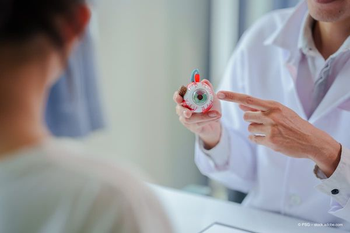
Clinical Trials at the Summit 2023: Update on avacincaptad pegol for GA
Margaret Chang, MD, MS, spoke with Modern Retina to give an update on avacincaptad pegol for geographic atrophy.
Video transcript
Editor’s note: Transcript lightly edited for clarity.
David Hutton: I'm David Hutton of Ophthalmology times. We are covering the Clinical Trials at the Summit program being held this year in Park City, Utah. I'm joined today by Dr. Margaret Chang. This presentation is of keen interest to ophthalmologists who are focusing on geographic atrophy. Thank you so much for joining us today. Tell us about your presentation.
Margaret Chang: Thanks, David. Well, I'm pleased to present the trial design and results of the pivotal gather one and gather two trials of avacincaptad pegol [ACP] for geographic atrophy. ACP is a synthetic pegylated RNA aptamer that's designed to be a specific inhibitor of complement C5. We all know that the complement system is important in the role of GA but this is a more downstream complement inhibition compared to C3 inhibitors.
So there's the potential to preserve anti-inflammatory properties of C3-A (inaudible) lead to some less (inaudible). In both the gather one and gather two studies, patients were included only if the GA was within 1500 microns of the foveal center that didn't involve the center itself. Gather one enrolled 286 patients in two different phases of the trial, each tested two different monthly doses of ACP versus sham.
The primary endpoint of the gather one study was the mean change in geographic atrophy area from baseline to month 12 using a square root transformation, that they did follow the patients out to 18 months. And in the gather two trial, 448 patients were randomized to monthly two milligrams ACP or sham, while the primary endpoint here was the mean rate of growth in geographic atrophy area as measured by the slope of GA growth from baseline to month 12.
So in year two, the patients in the ACP arm are then re-randomized, some monthly or bimonthly treatment, whereas the sham patients were continued on to sham treatment as well. So both the gather one and the gather two trials met their pre-specified primary endpoints. This is the first time in which an investigational drug for GA did meet the pre-specified primary endpoints at year one, and demonstrated statistically lower mean changes in geographic atrophy area from baseline to month 12 ACP. Two-milligram dosing had a reduction of 27.4% in GA growth for gather one trial, and 14.3% for gather two. The efficacy of treatment was seen early in both trials, as early as six months, but there was increasing efficacy and separation of the curves between treatment and sham as duration of the treatment progressed. They did also per provide subgroup analyses of different lesion characteristics, lesion sizes, autofluorescence characteristics, and these all did also show a benefit for the ACP treated groups.
But I think the most important parts of the trial results are the safety results, which showed an outstanding safety profile for ACP. In the entire gather one and gather two studies, there was only one case of intraocular inflammation. And that was one patient in the gather one trial, and there were no cases of endophthalmitis or optic neuropathy at 12 months. So that's really important too, given that we're often treating the only eye of these patients who've lost the other eye due to neovascular, AMD or central GA, we always do worry about the safety profile with new drugs that were that we're testing and treating in these patients. There was an increased risk of choroidal neovascularisation, which we would expect given any complement modulation. So this did occur in about 9% of VCP patients versus 2.7% of sham in gather one. In the larger gather two trial, this was 6.7% in the ACP arm versus 4.1% in sham. So we'll see how this plays out as longer-term data is available. In summary, I think this is really exciting data. I look forward to seeing what the two-year data of the gather to trial will be in the future. I'm really excited about what the future of ACP holds.
Newsletter
Keep your retina practice on the forefront—subscribe for expert analysis and emerging trends in retinal disease management.













































